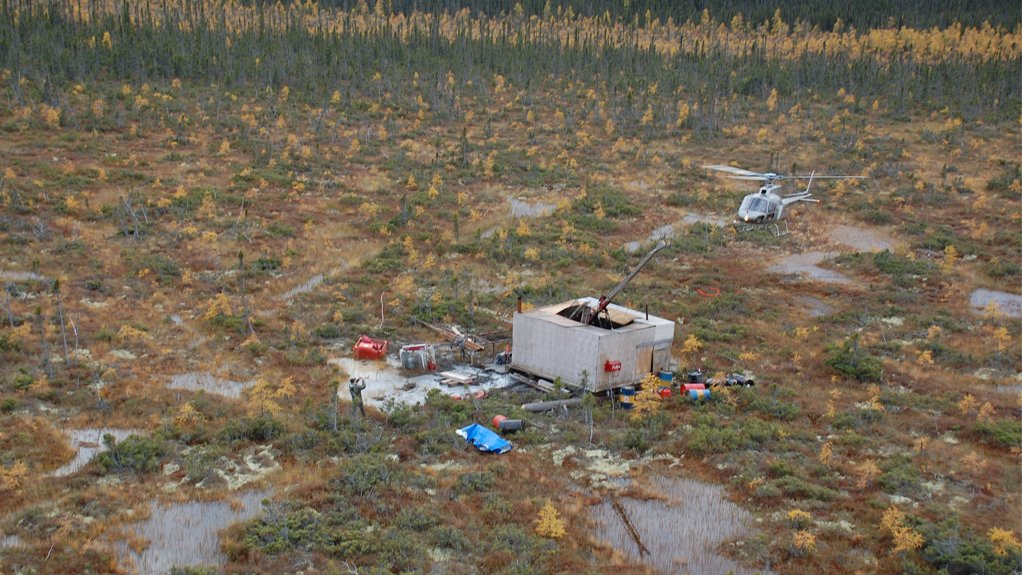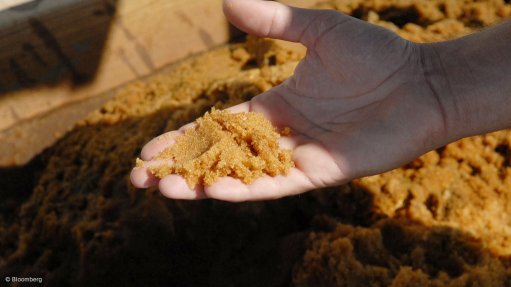KWG looks towards the East to finance its proposed Ring of Fire railway


KWG Resources undertaking drilling at the Big Daddy deposit, in the Ring of Fire.
Photo by KWG Resources
TORONTO (miningweekly.com) – KWG Resources is looking to the Far East to secure funding for its proposed 340 km rail corridor, which the project developer believes holds the key to unlocking the vast mineral wealth of the James Bay Lowlands of Northern Ontario.
“The reason KWG is looking to China to fund its proposed railway line is to increase the odds of securing an offtake partner, which is the critical prerequisite to making the emerging Ring of Fire (RoF) mining camp economically viable. The Chinese are the ultimate offtaker, since they use most of the steelmaking raw material,” said KWG president and CEO Frank Smeenk in an interview with Mining Weekly Online.
He explained that ferrochrome did not have a terminal market place like precious metals did, but instead relied exclusively on contract trading – the same as with iron-ore and coal.
“To make the deposit economic, it is a prerequisite to have an offtake partner,” Smeenk stated, noting that he was headed to China later this month to continue negotiations with interested offtake partners and to establish terms of reference required for a feasibility study to be undertaken by China Railway First Survey & Design Institute Group (FSDI) on KWG’s proposed rail route.
Smeenk stated that the company was carefully and systematically preparing to have the federal ministers in Ottawa informed of the impending international trade opportunity with China. Canada’s ambassador to China would be one of the first to be notified, as well as the Minister of Trade and the Canadian Prime Minister.
LONG-TERM SOLUTION
KWG announced late in December that FSDI had completed an initial analysis of KWG’s existing data and had indicated that the quality and extent of the information was sufficient for FSDI to undertake a feasibility study for a railway line connecting the RoF with global markets.
“Aiming to secure an offtake partner is a much smarter way of moving the project forward,” Smeenk underlined.
He said the company now planned to ship semi-finished product via its proposed railway, through Quebec, to the St Lawrence river, from where it would be able to reach global markets. Depending on the offtaker’s requirements, KWG would also have the opportunity to add other by-product metals, such as molybdenum and nickel, to the final product, thereby increasing its value.
This way, another significant provincial role-player would be brought into the fold, enhancing the RoF’s associated economic benefits. Bake into this equation low-cost long-term capital and some of the cheapest energy in the world, and one has the makings of an economically viable project, Smeenk noted.
KWG believed that trading Canadian-produced chromium billets – reduced by its patent-pending natural gas reduction technique in Nakina – with the Chinese and KWG for RoF rail infrastructure would allow Ontario to put its budgeted C$1-billion dollars into First Nations' service roads and social development projects to provide a turnkey solution that would help kick-start Ontario's economy.
Smeenk noted that China had about $3-trillion available for foreign investment, driven by its strategic need to secure future resources. “Securing long-term access to minerals is important for the Chinese and investing in a railway line to get product out of the RoF is a long-term investment, fitting the vision and ability of Chinese investors,” he added.
KWG had previously considered building a slurry pipeline over the same corridor which, albeit viable and cheaper, would in KWG’s and its advisers’ views not have provided the similar long-term benefits that a railway could bring to the region. Smeenk noted that, if financed creatively, at low interest rates and over a long period, the railway line remained the preferred transport method.
He noted that the two First Nations on whose land KWG held its mining claims had recently elected new chiefs, but that they remained “aggressively enthusiastic” and “pro development.” He insisted that the First Nations would be consulted at every step of the development process and would ultimately be the long-term benefactors of the RoF development.
Smeenk outlined that when construction of the railway line had started, it would necessarily require several roads to be built from access points to the west, along the north-south route, which stood to benefit First Nations after construction was completed.
LITIGATION UPDATE
Smeenk told Mining Weekly Online that KWG was imminently expecting the ruling of a three-judge panel of the Ontario Court of Appeal with regard to arguments presented by Noront Resources and the Attorney General of Ontario to the appeal of KWG’s subsidiary Canada Chrome Corporation (CCC).
To secure access to its mineral interests in the RoF, CCC, in an unprecedented move in 2010, staked mineral claims along a 340-km-long route covering a series of sand ridges over which it planned to build its railway, connecting to the Canadian National main line near Nakina, northwards into the RoF. These claims traversed the traditional territories of the Aroland and Marten Falls First Nations.
Early last year, CCC received an order of the Court of Appeal granting leave to appeal the decision of the Divisional Court of the Ontario Superior Court of Justice, released July 30, 2014, which ruled that CCC's consent should be waived in an application by Cliffs Natural Resources for an easement to build a road over its mining claims.
In Smeenk’s opinion, a judgment upholding the Divisional Court ruling that set aside the original decision of the Ontario Mining and Lands Commissioner, issued on September 10, 2013, and granted the application to dispense with CCC’s permission for an easement over its mining claims, would be hard to swallow for the Canadian judiciary.
He characterised the current relationship with joint venture partner Noront Resources as being cordial, but with less frequent communications than before. In April 2015, Noront had gained a majority land position in the RoF when it acquired Cliffs’ assets for $20-million. Noront also inherited the litigation started by Cliffs, contained in an Ontario-registered numbered company through the acquisition.
Meanwhile, Smeenk noted that Noront was selling royalties on its projects to stay financially afloat in the difficult market environment. This week it sold a 1% net smelter return royalty on the Eagle’s Nest deposit. Thus far, however, the Big Daddy chromite deposit, in which KWG owned a 30% stake, remained unscathed, but Smeenk said he was keeping a close eye on any potential royalty selling on the project.
Smeenk advised that KWG planned to raise some capital soon to enable it to undertake a drill programme on the Black Horse project, where it had the option to earn an 80% interest from Bold Ventures. It had recently reached an agreement to extend the deadline for the earn-in agreement by a year. KWG would have to spend about $2-million to drill three holes at a cost of about $600/m to $700/m.
Despite there never having been a worse time to raise capital, Smeenk said he was confident that KWG would be able to successfully complete its exploration programme. He also asserted that, owing to the recent progress being made on its initiatives, KWG was attracting the attention of significant international investors, which pointed to momentous and concerted interest in getting development in the RoF under way.
Comments
Press Office
Announcements
What's On
Subscribe to improve your user experience...
Option 1 (equivalent of R125 a month):
Receive a weekly copy of Creamer Media's Engineering News & Mining Weekly magazine
(print copy for those in South Africa and e-magazine for those outside of South Africa)
Receive daily email newsletters
Access to full search results
Access archive of magazine back copies
Access to Projects in Progress
Access to ONE Research Report of your choice in PDF format
Option 2 (equivalent of R375 a month):
All benefits from Option 1
PLUS
Access to Creamer Media's Research Channel Africa for ALL Research Reports, in PDF format, on various industrial and mining sectors
including Electricity; Water; Energy Transition; Hydrogen; Roads, Rail and Ports; Coal; Gold; Platinum; Battery Metals; etc.
Already a subscriber?
Forgotten your password?
Receive weekly copy of Creamer Media's Engineering News & Mining Weekly magazine (print copy for those in South Africa and e-magazine for those outside of South Africa)
➕
Recieve daily email newsletters
➕
Access to full search results
➕
Access archive of magazine back copies
➕
Access to Projects in Progress
➕
Access to ONE Research Report of your choice in PDF format
RESEARCH CHANNEL AFRICA
R4500 (equivalent of R375 a month)
SUBSCRIBEAll benefits from Option 1
➕
Access to Creamer Media's Research Channel Africa for ALL Research Reports on various industrial and mining sectors, in PDF format, including on:
Electricity
➕
Water
➕
Energy Transition
➕
Hydrogen
➕
Roads, Rail and Ports
➕
Coal
➕
Gold
➕
Platinum
➕
Battery Metals
➕
etc.
Receive all benefits from Option 1 or Option 2 delivered to numerous people at your company
➕
Multiple User names and Passwords for simultaneous log-ins
➕
Intranet integration access to all in your organisation



















